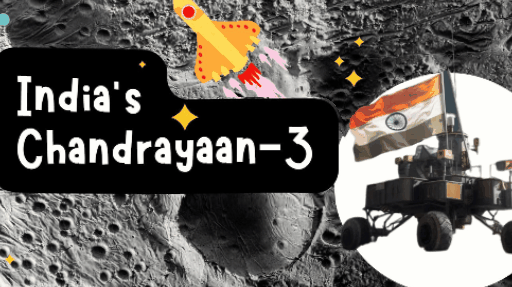Table of Contents
Chandrayaan-3,Touching the Moon’s Heart
On August 23, 2023, a momentous event lit up the skies—India’s Chandrayaan-3 mission gracefully landed on the lunar south pole. This remarkable achievement follows the footsteps of Chandrayaan-2, India’s initial lunar endeavor. The previous mission encountered a setback when its lander faltered during its descent, casting shadows of doubt. Now, Chandrayaan-3’s success emerges as a phoenix, igniting hopes and dreams while redeeming the Indian Space Research Organisation (ISRO).
A Trio of Exploration
Chandrayaan-3’s prowess lies in its threefold ensemble: a lander, a rover, and an orbiter. Named Vikram, the lander made its celestial debut at 12:33 p.m. UTC, securing its place on the lunar tapestry. Accompanying Vikram is Pragyan, the rover set to roam the lunar plains for up to 14 days, unveiling lunar mysteries. While these two make their mark on the surface, the orbiter continues its orbital dance around the moon, collecting precious data to unveil the lunar riddles.
The Enigmatic Lunar South Pole
Imagine a treasure trove nestled in the cosmic abyss—the lunar south pole. This region, drenched in shadows and veiled in intrigue, holds one of the universe’s most coveted secrets: water ice. This ethereal resource isn’t just a scientific curiosity; it’s the keystone for humanity’s future lunar escapades. Water ice offers not only sustenance for future astronauts but also a crucial ingredient for crafting rocket fuel, propelling us deeper into the cosmos. With Chandrayaan-3’s magnifying glass, scientists anticipate uncovering water ice’s distribution, a key to unlocking the moon’s potential.
America’s Cosmic Odyssey
In a dance of global collaboration, the United States also casts its eyes towards the lunar south pole. NASA’s Artemis program, set to debut in 2024, aims to land astronauts on the moon. The Artemis initiative isn’t just a hop, but a stride—a stride towards establishing a human foothold on the lunar surface. The lunar south pole, with its promise of resources and relative seclusion, beckons as a prospective haven for a lunar base.
A Triumph for India and Beyond
The victory of Chandrayaan-3 resounds not just in Indian soil but throughout the cosmic neighborhood. It symbolizes a testament to India’s technological prowess and a rising star on the global space stage. This achievement mirrors the burgeoning capabilities of nations to navigate the cosmos, challenging complexity and embracing audacious dreams.
Quests of Yore: Previous Lunar Pursuits
The lunar south pole has lured spacefarers for decades. In 1965, the Soviet Union’s Zond 3 spacecraft glimpsed the region but didn’t dare to land. The United States, in 1999, employed the Lunar Prospector spacecraft to map water ice’s presence, albeit without a landing. The European Space Agency (ESA), with SMART-1 in 2008, orbited the moon but refrained from touching its surface. Notably, China emerged victorious in 2019 with the Chang’e 4 spacecraft, making history by landing in the Von Kármán crater—a triumph that continues to unfold.
The Cosmic Ballet of Exploration
The successful touchdown of Chandrayaan-3 isn’t just an achievement; it’s an invitation to envision the future. This feat ignites a fire of inspiration, propelling nations towards the stars. This is not the conclusion; rather, it’s an overture, heralding a time when we will dance amongst the galaxies and weave dreams into constellations.
Unveiling the Lunar Canvas
Picture the rover’s radar survey—an enchanting waltz across the lunar expanse, revealing water ice’s hidden stories. The rover, Pragyan, isn’t just a machine; it’s a cosmic detective, unraveling the moon’s tales of composition and perhaps traces of past life. Meanwhile, the orbiter, a celestial cartographer, paints the moon’s portrait with each orbit, a masterpiece of lunar landscapes and atmospheric rhythms.
Cosmic Dreams: Into the Future
Chandrayaan-3 is more than a scientific quest; it’s a testament to human ingenuity and curiosity. It’s a beacon guiding us into a future where the cosmos is our canvas, and the stars our destiny. With every stride, we inch closer to a realm where humanity’s footprints dot the lunar plains, bridging Earth and the cosmos.
Shining Bright in the Cosmic Symphony
As the curtains rise on Chandrayaan-3’s triumph, humanity watches, captivated by the cosmic tale that unfolds. This is more than a mission—it’s an invitation to dream, to explore, and to reach for the stars. And as we stand at the threshold of the unknown, one thing is clear—the Chandrayaan-3 mission is our cosmic compass, pointing us towards a universe of possibilities.
For more valuable sports content, explore my other informative posts here.
References:


1 thought on “India’s Chandrayaan-3: Triumph at the Lunar South Pole”